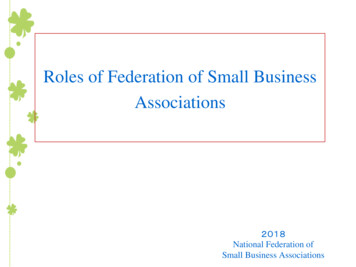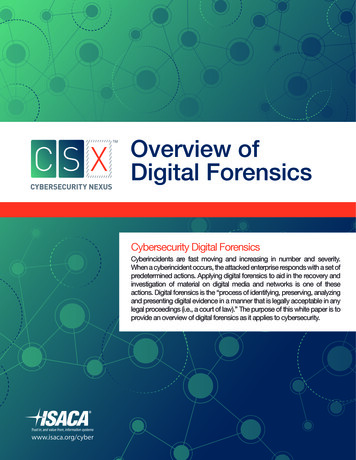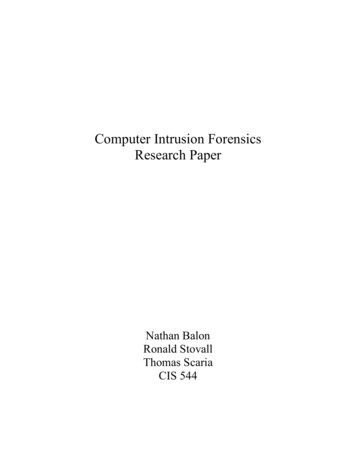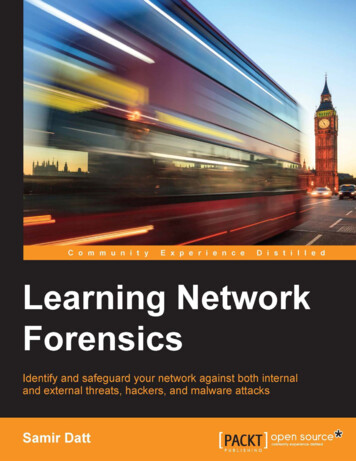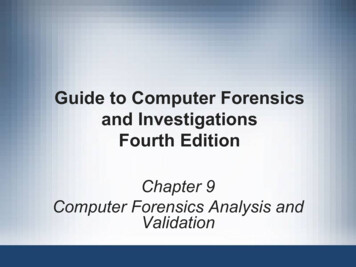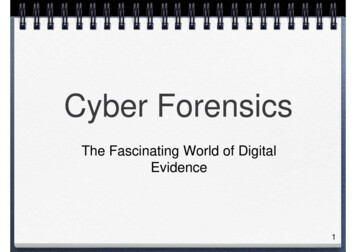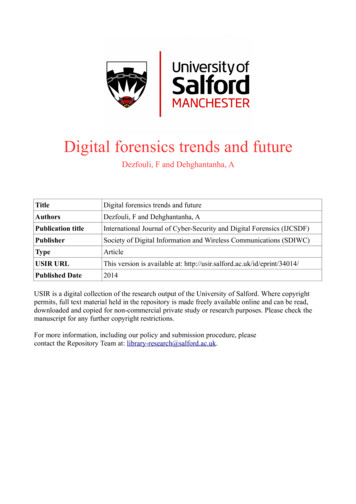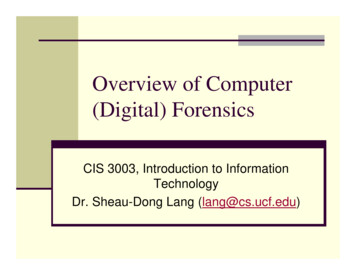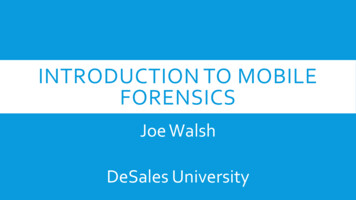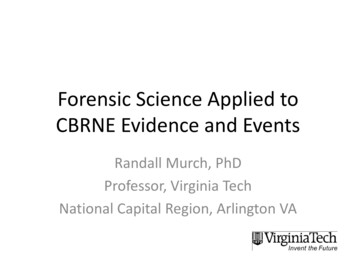
Transcription
DEPARTMENT OF DEFENSEOFFICE OF FREEDOM OF INFORMATION1155 DEFENSE PENTAGONWASHINGTON, DC 20301-1155JAN 28 2011Ref: 10-F-I062Mr. Steven AftergoodFederation of American Scientists1725 DeSales Street NW, Suite 600Washington, DC 20036Dear Mr. Aftergood:This responds to your November 14,2009, Freedom ofInformation Act (FOIA) requestfiled with the Office of the Director of National Intelligence. You requested a copy of thefollowing report prepared for the National Counterproliferation Center by the JASON advisorypanel: "Microbial Forensics" by T. Stearns, et aI, JASON Report No. JSR-08-512, 2008. OnMay 25, 2010, ODNI referred your request along with the responsive document to this office forprocessing and direct response to you. The Office of the Secretary of Defense/Joint Staffdetermined the enclosed document can be released without excision. This action closes yourrequest in this office.Sincerely,-?z -1' Enclosure(s):As statedPaul J. JacobsmeyerChief
FOR OFFICIAL USE ONLYMicrobial ForensicsMay 2009JSR-08-512Distribution authorized to US Goverms' Administrative/Operational Use;May 9, 2009.Other requests Iient shall be referred t o 'roHferation Center.JASONThe MITRE Corporation7515 Colshire DriveMclean, Virginia 22102-7508(703) 983-6997FOR OFFICIAL USE ONLY
FOR OFFIOIAL USE O 4LYContents1 EXECUTIVE SUMMARY12 INTRODUCTION52.1 Scope of the Study . 62.2 Tularemia and F. tularensis . 72.3 F. tularensis Genetics and Genomics . 102.4 Federal Microbial Forensics Infrastructure . 113 METHODS AND CRITERIA FOR DETERMINING GENETICRELATEDNESS133.1 The Implications of Mutation Rate and Clonal Growth forMicrobial Forensics . 133.2 DNA Polymorphisms, DNA Sequencing and Microbial Forensics . 153.3 Laboratory-based Experiments on Genetic Change vs.Natural Variation . 184 APPLICATION TO THE ATTACK SCENARIO215 CONCLUSIONS AND RECOMMENDATIONS256 REFERENCES27iiiFOR OFFIOIAL USE O 4L
FOR OFFIOIAL USE O 4L 1EXECUTIVE SUMMARYIntroductionMicrobial forensics is an emerging field devoted to the development of methods to characterizemicrobial samples for the purpose of comparative analysis in support of investigations intocriminal or terrorist acts. The comparison and classification of microbial isolates has been afocus of microbiological studies for more than 100 years. Historically, such comparisons haverelied on overt characteristics of microbes, such as cell morphology, Gram staining, serology,and growth on diagnostic media. The advent of DNA sequence-based methods has dramaticallyimproved our ability to discern relatedness between two isolates, and offers the resolutionrequired for attribution in forensic investigations. These same sequence-based methods ofcomparison are widely used in academic research in the fields of microbial evolution, taxonomy,and epidemiology. However, the needs of microbial forensics differ, in that the results may beused in criminal prosecution or in making national security decisions, and therefore greaterresolution and certainty are required.Study ChargeJASON was asked to address the development of a research roadmap that would provide anunderpinning for improved microbial forensic capabilities. The task scenario focused onFrancisella tularensis, the bacterial agent that causes tularemia. F. tularensis is a Select Agent,and considered to be a serious bioterrorism threat. In the scenario, a biological attack is carriedout in three u.s. cities over the course of one week, with samples available from victims at allthree attack sites, from patients, from a dissemination device found at one of the sites, and fromtwo sources collected by the Intelligence Community. The task was to determine the currentstate of genetic knowledge regarding F. tularensis, to identify gaps in that knowledge relevant tomicrobial forensics capabilities, and to propose a research plan that describes a scientific pathforward. Although F. tularensis was the task scenario organism, the research plan should be onethat allows for the broader microbial forensics capabilities that are needed.SummaryJASON considered the following specific areas:1) Methods and criteria for determining genetic relatedness1FOn OFFIOIAL USE O 4L'f
FOfil OFFIOIAL USE OP.L'(2) Laboratory-based experiments on genetic change vs. natural variation3) Metagenomics opportunities and concerns4) Potential for geolocationThe technologies for assessing genetic relatedness all depend on differences in DNA sequencebetween individual organisms. It is important to recognize that microbial DNA forensics isfundamentally different from human DNA forensics in that most microbes grow by asexualreproduction, and most are capable of a many-fold increase in cell number in a short time. Thispotentially results in a large number of individuals that are genetically identical. In contrast,every human being is genetically distinct (with the exception of identical twins), and can bedistinguished by assaying a small number of sites in the genome.The technologies in current use for genetic analysis in microbial forensics are of two sorts: I)assays in which known, genetically polymorphic sites are probed to determine the alleles present;and 2) whole genome sequencing, which does not depend upon prior knowledge. The existingpolymorphism assays differ in their level of resolution and in the rate of change of the specificpolymorphism assayed, but they have in common that they are rapid, inexpensive, and scalableto be high throughput. These assays are useful in situations in which rapid identification ofspecies and strain is required, for example, during the early stages of a natural outbreak orterrorist attack. However, whole genome sequence is vastly superior in information content, andshould be the method of choice when samples of forensic interest have been identified. The costin time and money of sequencing microbial genomes was a concern in the past, but nextgeneration sequencing technologies are emerging that generates very large amounts of sequencedata in a single run. These technologies are fundamentally different from traditional Sangersequencing in that the output is very many short-sequence reads that can provide greater than 30fold sequence coverage of the genome per run for a typical bacterial genome. The immediateconsequences of this new sequencing power are reflected in many of our conclusions andrecommendations.The primary conclusions of the study are that:1) Microbial forensics is a powerful tool, but is most useful as a complement to fieldwork, human intelligence, evidence gathering, and other traditional forms offorensics.2) Whole-genome DNA sequencing provides the ultimate level of genetic resolution forforensics and will replace the current forensic methods of analyzing DNA2FOR OFFIOIAL USE OP.L
rOft OFFIOIAL USE OP4L polymorphisms. It is also revolutionizing metagenomics. The microbial forensicscommunity should be at the forefront of this transition.3) A quantitative assessment of the meaningfulness ofa "match" for forensics is.difficult, because of the asexual growth of bacteria, lack of information aboutpopulation structure, mutation rate, and number of generations that separate twosamples, and the unknown effects of human intervention.4) Quality of relatedness information (phylogenetic trees) is limited by the quantity,quality, and diversity of the data collected.5) Although DNA-based methods of strain comparison are the most powerful, methodsthat exploit other signatures, such as gene expression and isotopic composition willlikely be important forensically.6) Improving microbial forensics capabilities also improves capabilities for analyzingnatural outbreaks, and vice versa.The chief recommendations of the study are the following:I) For all relevant pathogens, the National Biodefense Forensic Analysis Center (NBFAC)should sample the diversity of both natural and laboratory strains, and sequence at lowfidelity to get a sense of sequence variation. A few representative strains should bechosen for high-fidelity sequencing to establish "gold standard" sequences for eachpathogen. High-fidelity sequence of a related outgroup should also be acquired (Bacilluscereus for Bacillus anthracis, for example).2) The broad group of government agencies with an interest, including NBFAC, IC, FBI,CDC, and USDA, should develop and promote best practices for microbial samplecollection that best preserve the genetic and non-genetic signatures of interest.3) NBFAC, with its bioinformatics partners at LLNL, should exploit data from emergingmetagenomic projects to expand knowledge of natural diversity. Bioinformatics toolsbetter able to deal with this growing sequence database are needed. Some of these arecurrently being developed by the academic community, others by the commercialvendors of sequencing technology, but some may need to be developed in-house.4) The strain collection efforts ofNBF AC and the National Bioforensic ReferenceCollection should be expanded, with greater support, and coupled with the developmentof a relational database that includes genetic, geographic, and other contextualinformation. Sequences themselves, in addition to organisms, should be considered partof this database.3FOft OFFIOIAL USE OP4L
FOR OFFICIAL USEOP LYJASON also identified two longer-term. basic research goals that will impinge upon microbialforensics capabilities:1) . Develop capabilities for novel microbial forensics methods, such as transcriptomeanalysis, characterization of epigenetic modifications, and metabolomics.2) Develop the "pathogenome" (the molecular and genetic mechanisms of pathogenicity) asan organizing concept for microbial pathogens, complementing "species" organization.This study provided an opportunity to consider microbial genetics and population biology issuesin the context of forensics taking into account emerging technology that is changing the field.Studies of this kind will be useful in the future to keep abreast of how ongoing developments inscience and technology affect changing microbial forensics needs.4FOn OFFICIAL USE OP4LY
FOR OFFIOIAL USE OP4L 2INTRODUCTIONIn this report we summarize the considerations and conclusions of the 2008 JASON Summerstudy on Microbial Forensics. The charge to JASON, from the National CounterproliferationCenter (NCPC) was to:Develop a research roadmap to address and support criteria for 'match' determination asit pertains to genetic sequence variation comparisons for microbiological samples thatwould be compared as part of an attribution investigation.- Develop scientifically defensible standards- Account for differences between species and within species- Develop assurance and validation criteria- Identify the types ofbioinformatics tools needed- Describe ways in which to best leverage current and future technologicaladvances to support forensics.The specific context in which the above issues were considered was a forensic scenarioprovided by the sponsor:A covert biological attack is carried out in 3 separate US cities with no claims ofresponsibility over a period of 1 week. The attack in each case involved the covertrelease of a biological aerosol in a venue where a large number of people were eitherpresent or transiting through. The first evidence of an attack is derived by the appearanceof patients with severe pUlmonary infections and the etiologic agent is identified inclinical laboratories as Francisella tularensis type A. Approximately 5% of the casesresult in fatalities. Epidemiological investigation identifies the likely sites as a shoppingmall, a train station, and a movie theater. The FBI and other federal, state, and localagencies respond quickly to these suspected sites, and a large number of samples aretaken. In one instance a crude improvised dissemination device is recovered from an airduct at the movie theater; the device had some residual material in it, but wentundiscovered for several days following the attack. In addition to the environnientalsamples taken in each venue, the clinical samples recovered from the victims, and theresidual material present in the movie theater device, the FBI learns that the IntelligenceCommunity had several instances in which F. tularensis type A DNA signatures had beencollected from overseas exploitation operations. One of those operations involved a siteexploitation of a bombed out terrorist laboratory following counter-terrorism operations5FOR OFFIOIAL USE OP4LY
FOft OFFIOIAL USE OP4LYconducted by the u.s. military, and the second involved a freezer vial containing nonviable F. tularensis type A recovered from a suspect state-sponsored biological weaponsprogram. (Figure 1 illustrates the types of samples available for comparison).Available samples:devicepatientsenvironmental 'Analysis of a"bombed-out .terrorist lab"f. tularensis DNA .signatures:aVial of non·yjabteF. tularensis fromI; ;'l state-sponsoredL( program\/)'. .r;19',; Figure 1. Samples of Francisella tularensis organisms or DNAavailable for analysis in the attack scenario.2.1Scope oftbe StudyAlthough many types offorensic evidence would be useful in a case such as that provided in thescenario, JASON was asked to focus specifically on issues pertaining to genetic analysis ofsamples. Questions that arise directly from the attack scenario, and are potentially addressableby genetic comparisons, include the following:1) Was a single preparation of material used for all of the attack locations, or were multiplepreparations made?2) Can the samples from patients be related between attack sites, and between patients anddissemination device?3) Can F. tularensis in environmental samples at the attack sites be distinguished fromnaturally-occurring F. tularensis?4) Can samples of F. tularensis from domestic laboratories, or IC sources be definitivelylinked to the attack material, or excluded, based on genetic similarity? .6FOft OFFIOIAL USE ONLY
FOfit OFFIOIAL USE Ot4LY5) Is geolocation based on genetic sequence analysis feasible and could it be useful forattribution?In the course of addressing these questions we considered the state of knowledge for thepathogen in question, F. tularensis type A, but also considered the requirements for microbialforensics as they relate to bacterial pathogens more broadly because many of the issues arespecies-independent. Although viral and fungal pathogens are also potentially important threatorganisms, we were asked to focus on bacterial pathogens. We thank the following briefers forhelpful insights and discussion:NCPCPaul Keirn - Northern Arizona University, Flagstaff; TGen, PhoenixJohn Taylor - University of California, BerkeleyKostas Konstantinidis - Georgia Institute of TechnologyJames Burans - National Bioforensic Analysis CenterDavid ReIman - Stanford University2.2Tularemia and F. tularensisTularemia, popularly known as 'rabbit fever,' is an acute, febrile illness that results frominfection by the contagious bacterium Francisella tularensis. Initial symptoms of diseasetypically appear in 3-5 days, but depending upon the route and severity of the infection, thisincubation period can range from as little as 1 day to as many as 14 days. F. tularensis is themost infectious bacterial organism known: it as been estimated that just 10-50 bacterial cells areable to induce the life-threatening pUlmonary form of tularemia. Under current law F. tularensisis classified as a CDC Select Agent.The causative agent of tularemia was first isolated in 1911,in Tulare County CA, by notedbacteriologist Dr. Edward Francis, who traced an outbreak of fever to the local ground squirrelpopulation. Tularemia is a zoonotic bacterial disease that infects not only humans, but alsolagomorphs (rabbits, hares, and pikas), most common rodents (including squirrels, rats, voles,and mice), and some birds. Over 100 species of wild and domestic animals are known to harbortularemia bacteria, including sheep, cats, skunks, raccoons, and even pet hamsters. In the U.S.,major outbreaks of the disease have claimed commercially important numbers of sheep, mink,beaver, and foxes. The disease can also be spread by biting insect vectors, including ticks, fieas,deerflies, and mosquitoes. The animal reservoir (host) for F. tularensis is not presently7FOR OFFIOIAL USE Ot4L
FOR OFFIOIAL USE OP4L established, but dogs and wolves appear to be fairly resistant to infection and may also serve asmaintenance hosts for ticks.Four major subspecies ofF. tularensis are currently recognized. The subspecies are similarmorphologically, biochemically, and genetically, but differ in their geographical distribution. F.tularensis tularensis is prevalent throughout North America, including 49 of the 50 U.S. states(Hawaii being the sole exception), and is classified as the Type .A strain, which is responsible forthe most virulent form of the disease. The three Type B subspecies produce a milder form ofdisease that is rarely life-threatening in humans. These include: F.t. holartica, found throughoutthe Northern Hemisphere and the predominant form in both Europe and Asia; F.t. mediasiatica,found in some Central Asian Republics; and F.t. novicida, which is a comparatively rare strainfound mainly in North America, and more recently in Australia. The weakly virulent F.t.novicidastrain has been used as a basis for a tularemia vaccine, but that vaccine is in verylimited use and restricted to health care workers and others at specific risk for disease. Novaccine is currently available to the public.Widespread distribution of a vaccine against tularemia is not thought to be necessary. Despitethe highly infectious nature of Type A strains, the disease is not common in the U.S. humanpopulation. Throughout the 1930's and 1940's, 2,000-3,000 cases per year were reported, andmany of these were attributable to eating contaminated meat, coming mainly from the hunting ofdiseased squirrels and rabbits during the Depression era. With the subsequent reduction in suchhunting, the incidence of tularemia decreased markedly, with only 1,368 cases reported duringthe decade of 1990-2000. Sixty percent of those cases came from just four states where squirrelsand rabbits are still hunted (AR, MO, SD, and OK). Today, tularemia is rarely fatal whenpromptly diagnosed because the causative agent is susceptible to a wide variety of antibiotics.Given its low incidence and mortality rates, tularemia was removed from CDC "reportabledisease" status in 1994. However, it was reinstated as a reportable disease in 2000 because ofcontinuing concerns that F. tularensis might be used as an aerosolized bioweapon.·Arguably, F. tularensis may have been the first bioweapon to be used in recorded history. Theancient Hittites, who lived in portions of what is today Syria and Turkey, were reported to havesupplied "cursed rams" carrying disease to their enemies, the Arzawans, in the year 1,320 B.C.E.By some accounts, the circumstances and symptoms were consistent with the ingestional form oftularemia. More recently, tularemia bacteria were weaponized by BW programs in both theformer Soviet Union and the United States. Both sides developed imperfect tularemia vaccinesas well, which tended to produce adverse reactions and were not well-suited for general use.8FOR OFFIOIAL USE OP4LY
Fon OFFIOIAL USE ONLYAccording to Ken Alibek (Kanatjan Alibekov), a defector who served as the First DeputyDirector ofBiopreparat, the Soviet program had worked to genetically engineer a "tripleresistant" strain of Francisella during the 1970's and 1980's that would retain wild-type levels ofinfectivity while evading a spectrum of antibiotics, but was unsuccessful. It is reported that theU.S. stocks ofweaponized F. tularensis were destroyed in 1973 and the former Soviet programwas abandoned in 1992.Tularemia is notable for the many ways that one can get the disease, as well as the wide varietyofforms that it can take. Francisella infection can occur across the skin or mucous membranes,through minor cuts or abrasions, or via the bite of an infected insect or rodent. Infection by thisroute causes the ulceroglandular form of the disease, which accounts for 75-85% of all reportedcases. Untreated, ulceroglandular tularemia has a 5-7% mortality rate. The overall casemortality rate for all forms in the U.S., with treatment, was just 1.4% between 1985 and 1992.The second-most common form of tularemia is the pulmonary, or pneumonaic form.Approximately 30% of natural cases are estimated to be of this type, and it is also the form thatwould be produced by a deliberately aerosolized BW agent. Pulmonary tularemia is the mostlethal form of the disease, with a mortality rate of close to 50%. In nature, the pulmonary formcan be acquired by the inhalation of aerosolized particles bearing live bacteria, such as thoseproduced by the handling of contaminated rabbit pelts, spoor from infected animals, or even soilor road dust. An outbreak of tularemia in 2000 in Martha's Vineyard that produced 15 cases ofpneumonaic tularemia with one fatality (and has had recurrences every summer since that time)has been attributed, without direct evidence, to the exposure of landscapers to aerosolized lawnclippings.Tularemia may be acquired by ingesting contaminated meat or water, where it causes the socalled typhoidal form. Tularemia bacteria represent one of only two Select Agents known tomaintain virulence in water, the other being anthrax spores. Typhoidal tularemia is fairlyuncommon, but the mortality rate is high, similar to that for pulmonary tularemia.Pre-9fll, the CDC estimated (in 1997) that the cost ofa deliberate attack on the U.S. withaerosolized tularemia might be S.4B per 100,000 people infected. However, improved methodsfor diagnosis, general awareness ofBW threats, and the numerous countermeasures taken by theu.S. government since the anthrax letters attacks during Fall 2001 have all likely reduced thatnumber substantially. Still, given its natural properties, F. tularensis remains a leading candidatefor an agent to be used in a BW attack. Finally, because F. tularensis type A is an endemicspecies in the U.S., with a broad distribution, it poses significant problems for the current9FOn OFFIOIAL USE OPdLY
FO OFFICIAL USE OP4L generation ofbiodetectors that attempt to score the presence of aerosolized bacteria. Thepublicized cases of these ultra-sensitive detectors detecting F. tularensis attest to the Ubiquity ofthis organism in our natural environment.2.3 F. tularensis Genetics and GenomicsThe complete genome sequence of F. tularensisstrain Schu S4 has been determined (Larsson etaI., 2005). The genome is a 1.89 Mb circularchromosome with approximately 1,800 predictedprotein coding sequences. Like most bacterialgenomes, the F. tularensis genome contains many100.100 100.100transposable elements, including 50 copies of atransposon belonging to the Tc-l mariner family.Interestingly, this transposon is usually found ineukaryotes, and it is possible that it was acquired1 .1():1L- ': MJg"":";:'1(0).100from an insect host.The genome sequence, as well as previous 16SRNA sequence analysis, suggests that F.tularensis has no close relatives among knownpathogens. Figure 2 shows a phylogenetic treeFigure 2. Phylogenetic relationship of 16including F. tularensis a:nd other bacterialpathogens.The virulence mechanism of F. tularensis is notwell-understood, but it is known that genes withina pathogenicity island relevant to growth withiny-proteobacterial species inferredfroin aconcatenated alignment of ten proteins.The topology, branch lengths andbootstrap support are according to thereconstruction with the neighbor-joiningmethod. From Larsson et a1. (2005),macrophage cells are regulated by thetranscription factor MglA (Lauriano et aI., 2004). Indeed, microarray analysis of genes regulatedby MglA has recently identified five previously uncharacterized virulence factors (Brotcke et aI.,2006).A second whole genome sequence of an F. tularensis isolate was recently reported (BeckstromSternberg et aI., 2007). The F. tularensis type A subspecies is composed of two clades, A.I andA.1I. There is some geographical separation between the two clades, with A.I being found10FOn OFFIOIAL USE OP4LY
FOR OFFIOIAL USE OP4L'fpredominantly in the southern u.s., and A.II in the mountainous western U.S. The Schu S4strain sequenced by Larsson et al, (2005) is an A.I strain, whereas the newer sequence is from anA.II strain. There are more than 4,000 polymorphisms between the two genomes, as well asmore substantial rearrangementS, often flanked by transposable elements. Interestingly, a largenumber of transposon-flanked genome rearrangements were also noted in comparison of theSchu S4 sequence with that of a F. tularensis type B isolate (petrosino et al., 2006). Although itis difficult to correlate estimates of divergence rate with real time, based on the degree ofdivergence it is clear that the two type A clades ofF. tularensis separated from each other longago.2.4 Federal Microbial Forensics InfrastructureA presidential directive dated April 28, 2004 named the National Bioforensic Analysis Center(NBFAC) as "the lead Federal facility to conduct and facilitate the technical forensic analysisand interpretation of materials from biocrime and bioterror". NBFAC is one component of theNational Biodefense Analysis and Countermeasures Center (NBACC), under the Department ofHomeland Security. The other component is the Biological Threat Characterization Center(BTCC), which conducts studies and laboratory experiments to better understand biologicalthreats. NBFAC has a "hub and spoke" organizational structure (Figure 3), with FBI and othercustomers providing samples for analysis, the NBF AC hub conducting casework, evaluating andvalidating new assays, and maintaining continuous operation. A variety of spoke affiliatesprovide surge capacity for casework, and increased analytic capabilities; these include LawrenceLivermore National Laboratory (LLNL) for bioinformatics, the Chemical and BiologicalInformation Analysis Center (CBI) for mass-spectrometry characterization of chemical samples,and the Naval Medical Research Center (NMRC) for expertise on Rickettsial diseases. NBACCand NBFAC will be housed in a new building to be completed in early 2009. JASON hadextensive discussions with James Burans, Ph.D., Director ofNBFAC, and was convinced of thebenefits of this integrated program for addressing bioforensic challenges.11FOn OFFlOIAl USE OP4LY
FOR OFFIOIAL USE OP4LYFOR OFFlOIJlrL USE OP4LY
fiOfit OFFIOIAL USE O 4L .3METHODS AND CRITERIA FOR DETERMINING GENETICRELATEDNESSWhen a sample of interest is referred to NBFAC, a range of tools are applied to detennine thenature of the organism in question (Figure 4). These include traditional microbiological assays,such as tests of ability to metabolize different sugars, immunological methods that recognizesurface molecules, and electron microscopy to determine morphology (Figure 4). Each of these. . -"-.,,-. ".-.",.--,. Unknown.SampleAntigen DetectionGenetic Identification;"", J ' ': . . . . ."."j.",:",.""!"'fI," .M . .Culture/PhenotypicCharacterizationElectron MicroscopyFigure 4. Tools used to characterize unknown microbial samples atNBFAC. Courtesy of James Burans.tools has advantages, particularly when material is limited or when a rapid determination ofspecies is needed. However, only genetic identification has the resolution required for forensicinvestigations in which the relationship between two isolates is the key issue, and we thereforefocus on that method.3. 1 The Implications of Mutation Rate and Clonal Growth for Microbial ForensicsAll genetic methods of identification depen4 on nucleic acid sequence polymorphism betweenorganisms. It is instructive to compare the nature and meaningfulness of genetic comparison forhumans and bacteria. Knowledge of polymorphic loci in humans has led to powerful assays toidentify individuals uniquely for forensic investigations. Given the number of humans on earth(approaching 7 x 10\ a relatively small number of polymorphic loci suffice for unique13FOn OFFIOIAL USEO 4LY
FOR OFFlCI,ArL USE OP4L identification. The DNA Identification Act (1994) led to the establishment by the FBI of a. Combined DNA Index System (COOlS) that is now used in the U.S. and more than 25 othercountries (Baechtel et at, 1991). CODIS makes use of 13 loci in the human genome that can bedistinguished by simple polymerase chain reaction (PCR) assays; the profile of alleles at theseloci in different populations within the U.S. is known. The genetic diversity created by sexualreproduction in humans is such that, other forensics issues aside, assaying the alleles presents atthe COOlS loci allows a unique match to be made between a forensic sample and an individualhuman. An obvious exception is identical twins, who would be indistinguishable by the COOlSassays.We wish to stress that there is afundamental difference between theuse of genetic markers for forensics inhumans compared to their use inmicrobial forensics. Most microbesreproduce asexually, so that vastnumbers of "individuals" can beBase pairs per genome:-5 x 10·Cells per colony (plate): -10'Cells per liter of culture: -10 12Mutation rate in E. col;: -10·'(pet"basepair pet" replication; numb«genetically identical, or nearlyof replications [cell number-1]1identical. Figure 5 shows some of theNumber of H. sapiens:-6.7 x 10'relevant numbers to consider. Theaverage bacterial genome consists ofsev
microbial forensics capabilities, and to propose a research plan that describes a scientific path forward. Although F. tularensis was the task scenario organism, the research plan should be one that allows for the broader microbial forensics capabilities that are neede
